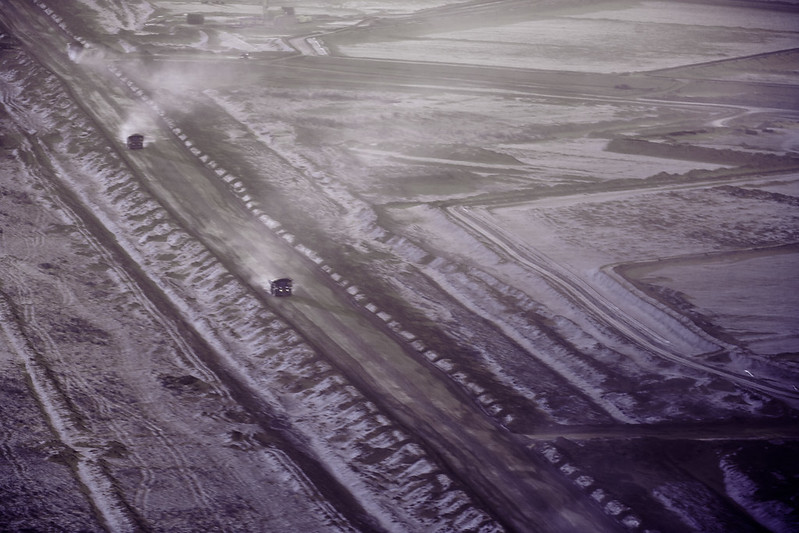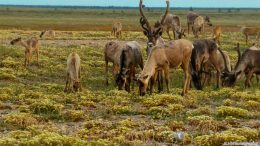A logged forest is a changed forest, and for woodland caribou that could mean the difference between life and death.
A recent study in the Journal of Wildlife Management tracked the survival rates and population growth of woodland caribou (Rangifer tarandus caribou) across two areas of northern Ontario, Canada. In one area about a third of the forest had been logged 30 to 50 years ago. In the other, the only disturbances were from natural events.
The research found “substantial differences” in the survival of adult caribou between the two areas.
The animals, it turned out, fared considerably worse in the previously logged landscape — so badly that the researchers, led by John Fryxell, a professor at the University of Guelph and executive director of the Biodiversity Institute of Ontario, concluded it would lead to a dwindling population. The unlogged habitat, however, they found “should be considerably more capable of sustaining caribou.”
The high mortality rates for the caribou in the logged forest are mostly due to wolf predation, but human changes to the landscape help make that possible. Development has been a driving force behind declining caribou numbers throughout their range.
As a result of these human disturbances, the caribou population in North America is in a precarious position. Woodland caribou once ranged across half of Canada and the northern reaches of the contiguous United States. But they’re now gone from their southern range. In Canada’s boreal forests, the animals are listed as threatened under the federal Species at Risk Act, Canada’s version of the Endangered Species Act.
While woodland caribou have evolved to live with forests disturbed by wildfire, they haven’t fared well in forests disturbed by people. One of the biggest threats is habitat fragmentation from commercial logging, mining, oil and gas — and all the roads associated with those activities.

But here’s the twist: Moose do better in these disturbed landscapes, and that puts caribou further at risk, albeit indirectly.
Previous research has found that moose prefer the vegetation that grows in these early successional forests that follow a large-scale disturbance, like commercial logging. And a higher density of moose attracts more wolves, which are also able to move faster and hunt farther by following linear clearings like roads and pipelines in these developed areas.
While moose are the primary prey for wolves, caribou that wander into these forests become another tasty target.
“The bottom line,” Fryxell explains, “is that the combination of vegetation changes, increase in road density, increase in moose, and consequent increase in wolves threaten long-term viability of woodland caribou in boreal landscapes of Ontario, in a similar fashion to many other parts of Canada.”
A national assessment found that around 70% of Canada’s local populations of woodland caribou were no longer self-sustaining.
So what’s to be done?
Last year provincial managers in Quebec floated the idea of killing wolves to protect caribou herds. Their idea met with public backlash, but wolves in British Columbia weren’t so lucky. During the winter of 2019-2020, a whopping 463 wolves were killed by the B.C. provincial government for the stated purpose of protecting populations of southern mountain caribou, another caribou ecotype.
Some of the money to pay for the kill came from Coastal GasLink, a company actively clearing land in caribou habitat for a pipeline, the Canadian news outlet the Narwhal reported.
And a recently published study in the journal Biodiversity and Conservation found that the culls were not likely to aid caribou and pointed out several shortcomings in previous research that called for such wolf-control measures.
There are other, and better, options — like habitat protection and restoration.
Fryxell’s study concluded that “the most secure conservation measure would be to set aside extensive tracts of boreal forest with natural patterns of disturbance to sustain viable caribou sub‐populations.”
Research shows that the animals need at least 65% of their range undisturbed to have a good shot at survival.
And helping caribou will come with other environmental benefits. Canada’s 2018 federal action plan to restore caribou stated, “Boreal caribou is also considered by many to be an indicator of the overall state of Canada’s boreal forest ecosystem.” So keeping forests intact or restoring habitat is a proposition that would benefit not only caribou but many other species.
![]()


